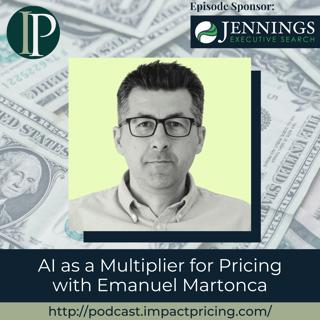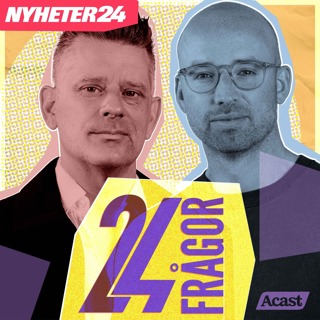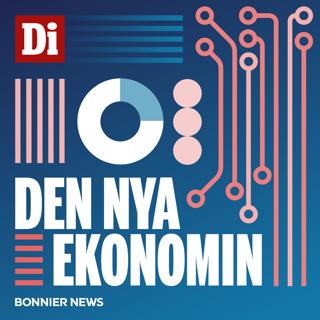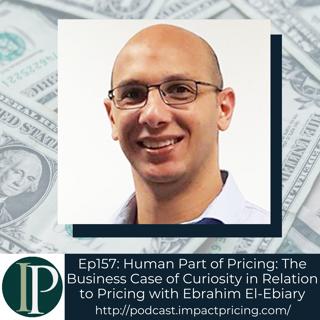
Human Part of Pricing: The Business Case of Curiosity in Relation to Pricing with Ebrahim El-Ebiary
Ebrahim El-Ebiary is a Pricing Manager at Goodyear Tires. He’s been with Goodyear for six years now, having worked in Revenue Management at FedEx before that. Ebrahim is a Professional Certified Coach and he's genuinely interested in people and how they think. In this episode, Ebrahim talks about the importance of curiosity and good relationship to your pricing practice as you continue to make money through helping your customers do the same. Why you have to check out today’s podcast: Learn about what revenue management is and the relationship it has with pricing Understand why it’s important that pricing people understand their customers’ future while having the customers take part in the creative process Find out about the benefits of having a good relationship with your customer and keeping that relationship until it lasts “Before launching a very detailed analysis, ask the question, ‘how will this be used?’” – Ebrahim El-Ebiary Topics Covered: 01:11 – How Ebrahim got into pricing 01:59 – Revenue management’s relationship with pricing and yield management 03:48 – Does Goodyear have revenue management? 04:40 – Defining a coach and what a coach does; Is Mark a coach? 06:05 – Pricing and coaching as different sides of the same coin 07:50 – Why curiosity is important in keeping relationships with customers 09:27 – Questions to ask in order to better understand a customer’s future 11:53 – Why it’s important for tires to be talking to each other 14:26 – Where the idea of communicating tires came from 15:42 – Having the customers take part in the creative process and keeping that relationship with them 19:08 – Being in a zero-sum game situation of price negotiation 23:12 – Expressing complex analysis into simple statements to not lose your customers 26:32 – Pricing advice for today’s listeners Key Takeaways: “A coach is someone that supports people getting from where they are to where they want to get to, not where he or she wants to get, where they want to get to. A coach does not tell you or does not impose their point of view.” – Ebrahim El-Ebiary “Making money is “the easy part” of it (doing business). Having the story and the vision, now that's where moneys truly made in a sustainable manner.” – Ebrahim El-Ebiary “Discovering the future comes from asking about the legacy that they want to build mixed with free flow working sessions where we pick on each other's ideas jointly.” – Ebrahim El-Ebiary “One thing remains at the heart of business is people. Once we lock in that relationship of trust and joint creativity, then we come back to do business together. That relationship then grows and flourishes, and with that, profits grow and creativity grows and the demand for new products that didn't exist or new services from existing products come to life.” – Ebrahim El-Ebiary “Know the question you're trying to answer before jumping into a detailed analysis or investing in a pricing system software, hiring more people. Just know what question you're answering.” – Ebrahim El-Ebiary People / Resources Mentioned: Goodyear Tires: http://www.goodyear.com/ Connect with Ebrahim El-Ebiary: LinkedIn: https://www.linkedin.com/in/ebrahim-elebiary/ Email: ebiary@gmail.com Connect with Mark Stiving: LinkedIn: https://www.linkedin.com/in/stiving/ Email: mark@impactpricing.com
24 Jan 202228min

Blogcast #38: The Best Attitude for a Great Value Conversation
This is an Impact Pricing Blog published on December 15, 2021, turned into an audio podcast so you can listen on the go. Read Full Article Here: https://impactpricing.com/blog/the-best-attitude-for-a-great-value-conversation/ If you have any feedback, definitely send it. You can reach us at mark@impactpricing.com. Now, go make an impact. Connect with Mark Stiving: Email: mark@impactpricing.com LinkedIn
21 Jan 20222min
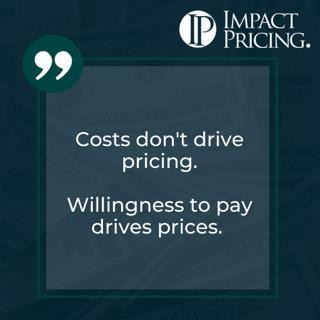
Memecast #41: Costs Don't Drive Pricing
Costs don't drive pricing, willingness to pay drives prices. I remember 1989. Yes. I'm that old? I was selling automatic test equipment to the semiconductor industry, and I heard this story on the radio that changed the way. I thought about pricing and costs forever. Intel built the 46 DX, which is the very first dual-core microprocessor in the world. Very expensive. Of course, AMD decided they were going to create a single core version and they charged a much lower price. So they've taken a lot of business away from it. Yeah. Intel's thinking ‘Hey, we better do something’. So Intel creates a single-core version of their microprocessor and they charge a price more competitive with AMD. And so now they're not losing quite as much business. Now, this story makes all the sense in the world until you learn how Intel made the SX. They first made a DX, a dual-core processor, and then they took an extra manufacturing step with a laser to disable the coprocessor. It actually costs them more to build an SX, a single-core version than it did to build the dual-core version. And yet they sold it at a much lower price. Well, how does that possibly make sense? It makes sense because. Our costs. Aren't what drives our customer's willingness to pay? It's the value to the customer that drives their willingness to pay. We should stop overemphasizing our costs, especially when we're trying to set pricing. It's really about customer value. We hope you enjoyed this podcast. If you see have any questions or feedback please email me mark@impactpricing.com. Now go make an impact. Connect with Mark Stiving: Email: mark@impactpricing.com LinkedIn
19 Jan 20222min
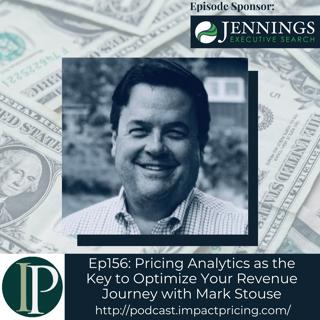
Pricing Analytics as the Key to Optimize Your Revenue Journey with Mark Stouse
Mark Stouse is the Chairman and CEO of Proof Analytics. He was 2020’s Top 10 Most Influential Analytics Leaders. He was also CMO/CCO at Honeywell Aerospace, so he has tons of experience. Mark also hosts his own podcast called “Accelerating Value”, a weekly podcast aimed at guiding people in creating, defending, and proving value with the help of experts. In this episode, Mark discusses how analytics lead SaaS businesses to success as he shares insights most SaaS entrepreneurs need to know about the relationship between analytics and pricing. Why you have to check out today’s podcast: Discover how a different way of consulting like analytics can help SaaS businesses to become profitable nowadays; Know how much of a game changer analytics is in terms of keeping the relationship between customer loyalty and pricing intact; Find out how the scientific sense of inquiry helps pricing people reach greater heights in relation to sales and pricing with clients “It isn't that you say, ‘Hey, what are you willing to pay for this?’ That's not the question. You've got to say, ‘tell me about what you're really trying to solve for here and how big a problem is this to you. What would make you feel spectacular?’ Then let's talk about the technical realities, and then let's talk about a price.” – Mark Stouse Topics Covered: 02:02 – Getting exposed to pricing and learning things through failures with Mark’s experience in Honeywell Aerospace and Proof Analytics 04:06 – Diving into the world of pricing with the help of advisors he trust 06:41 – Starting out in a SaaS company and initially doing consulting: a good way for one to be profitable 09:02 – A different consulting model – analytics – for a better, faster, and cheaper reality nowadays 13:16 – Business and the gap it has with data scientists due to the lack of contextual understanding in both concepts 18:23 – What does Proof Analytics charge for and why is that the right thing for them to charge for? 20:20 – Talking about the concept of 10 models equals 10 questions and how COVID affected the business industry in the past two years 26:05 – The differences in the opportunity costs of small and large companies 30:23 – A model as an indicator of customer success and people’s obsession with margins 33:25 – What makes SaaS beautiful is that it concerns value at all times 35:30 – Mark’s pricing advice for the listeners Key Takeaways: “If you want to talk about a lesson in the reality of economics, start a SaaS company and you will learn more than you ever dreamed was out there.” – Mark Stouse “The problem has been not the math and not even the data. It has been the issue of how do we operationalize analytics so that everybody is able to make a better decision today than they were making before when they didn't have analytics. It really is taking the existing reality and making it better, faster, cheaper.” – Mark Stouse “Data scientists really don't typically have much subject matter expertise about any part of the business, so as the business person, you have to be very prescriptive with the data scientist in terms of laying out the non-mathematical equation.” – Mark Stouse “If you're a very large enterprise and you're spending $150-$200 million on marketing, what you are really after is maximizing the upside and minimizing the negative impact EPS from bad investments. That's what you're really after. If you are a much smaller company, you're really trying to avoid, among other things, being a two-time loser.” – Mark Stouse “The intersection of customer loyalty and pricing is also a piece that is usually ignored, because pricing is seen in a very short cycle sense rather than something that's a longer time.” – Mark Stouse “The human being has become key to the success of set which probably really and truly always was or should have been. There was just this unhealthy obsession with 90% profit margins.” – Mark Stouse People / Resources Mentioned: Proof Analytics:https://www.proofanalytics.ai/ Honeywell Aerospace:https://aerospace.honeywell.com/ Connect with Mark Stouse: LinkedIn:https://www.linkedin.com/in/markstouse Email: stouse@proofanalytics.ai Connect with Mark Stiving: LinkedIn: https://www.linkedin.com/in/stiving/ Email: mark@impactpricing.com
17 Jan 202238min
